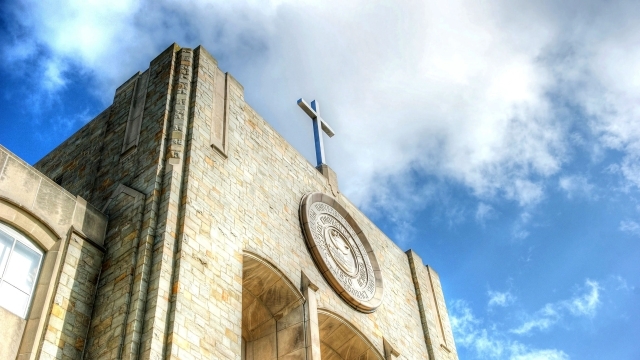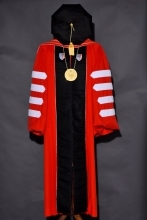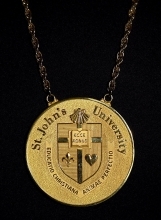

Academic Traditions and Symbols
- Home
- Who We Are
- Leadership and Administration
- Office of the President
- Presidential Investiture
- Academic Traditions and Symbols
September 24, 2021 | 3 p.m. | Carnesecca Arena

Presidential Regalia
The St. John’s presidential regalia is a distinctive red robe, based on the traditional doctoral gown, with four white velvet chevrons on each sleeve. The four chevrons are a symbolic element used only on presidential regalia. The presidential regalia is indicative of the academic life of the university, which is led by the president. St. John’s president wears a doctoral cap and hood representative of his degree-granting institution.
Presidential Medallion

The medallion worn by the president bears the crest of the University on its face. It is symbolic of the president’s custody of the official St. John’s seal and the authority and responsibility to use it wisely and judiciously. The medallion is presented at the president’s investiture signaling the beginning of his or her tenure in office. The president wears the medallion at commencement ceremonies and other formal academic functions of the University.
University Crest

The redesigned crest restores the original blue and red, liturgical colors evoking the “Blessed Virgin and the Humanity of Her Divine Son.” The white cross at its center further identifies Christ as the foundation and model for a moral, ethical character, as does the motto Ecce Agnus (“Behold the Lamb of God”), recalling St. John the Baptist’s testimony to the divinity of Christ. The fleur-de-lis symbolizes France, homeland of St. Vincent de Paul. The heart represents his commitment to charity. The escalloped shell—an ancient symbol of the sacrament of baptism—signifies St. James the Greater, titular of the cathedral of the Diocese of Brooklyn, where the University was founded. The shell also recalls a Native American name for Long Island: “Sewanhacky” (“Island of Shells”).
Especially prominent is the banner encircling the lower half of the crest. It bears the motto “Educatio Christiana Animae Perfectio” (“Christian education perfects the soul”), a testament to the ethos that guides St. John's University.
University Mace

The University Mace was created at the request of the president of the university in the early 1960s by Rev. Lawrence Lonergan, C.M., chairman of the fine arts department.
The academic mace traces its origins to the heavy, armor-breaking club knights used in the Middle Ages. In the less-militaristic climate of today’s Academy, the mace, a symbol of faculty and students, announces by its presence that those who follow bear the power of higher learning, which dispels the darkness of ignorance and oppression more certainly and peaceably than any weapon of war.
The mace bearer is the grand marshal, a faculty member chosen by the provost for distinguished service and accomplishments.
The university mace measures 39 inches and weighs five pounds and two ounces.
The symbols on the St. John’s University mace are all based on the iconography associated with St. John the Baptist, patron saint of the University.
- The dove at the top symbolizes the Holy Spirit. According to the Gospel narrative, the Holy Spirit in the form of a dove descended on Christ while being baptized by John the Baptist. The circle around the dove symbolizes a halo indicating holiness.
- The red enamel CHI/RHO design is an emblem of Christ. The wavy lines surrounding the globe symbolize the waters of the River Jordon/waters of baptism.
- The silver knop is seven sided. Three sides carry design:
- The University Crest
- The University Seal
- The Seal of the Congregation of the Mission
Academic Regalia
The caps, gowns, and hoods worn at college and university functions date back to the Middle Ages. Monks and students of those days wore them to keep warm in the damp and drafty 12th-century castles and halls of learning.
The gown for the bachelor’s degree has a semi-stiff yoke, long pleated front, and intricate shirring across the shoulders and back. It is primarily distinguished by its long pointed sleeves.
The holder of a master’s degree wears a gown with the same yoke effect as the bachelor’s. The gown, however, is worn open, and the very long sleeve is squared and closed at the end, the forearm coming through a slit near the elbow.
The gown for the doctor’s degree is also worn open. It has broad velvet panels down the front and three velvet bars on the large, bell-like sleeves. This velvet trimming may be either black or the color distinctive of the field of learning to which the degree pertains.
Generally, all caps may be of serge or broadcloth. In addition, doctor’s caps may be of velvet and adorned by a gold tassel.
The hood gives color and distinction to the academic costume. The hood—a black shell-like affair of varying size for the three degrees and material to match the gown—is silk-lined, stressing the colors of the institution conferring the degree. The hood is then bordered with velvet of the color signifying the respective fields of learning.
